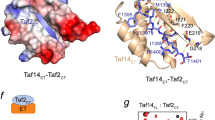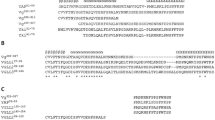Abstract
Using the S2 cell system of Drosophila melanogaster, it was shown that the key protein domain mediating the interaction of TFIID and Brahma transcriptional complexes within the BTFly supercomplex is the evolutionary conserved SAY domain of SAYP. TFIID and Brahma coactivators participated in the reporter gene activation induced by the SAY domain in cellular nuclei. The components of TFIID and Brahma directly interacting with SAY were identified.
Similar content being viewed by others
References
Georgiev P.G., Gerasimova T.I. 1989. Novel genes influencing the expression of the yellow locus and mdg4 (gypsy) in Drosophila melanogaster. Mol. Gen. Genet. 220, 121–126.
Shidlovskii Y.V., Krasnov A.N., Nikolenko J.V., Lebedeva L.A., Kopantseva M., Ermolaeva M.A., Ilyin Y.V., Nabirochkina E.N., Georgiev P.G., Georgieva S.G. 2005. A novel multidomain transcription coactivator SAYP can also repress transcription in heterochromatin. EMBO J. 24, 97–107.
Wu J.I., Lessard J., Olave I.A., Qiu Z., Ghosh A., Graef I.A., Crabtree G.R. 2007. An essential switch in subunit composition of a chromatin remodeling complex during neural development. Neuron. 55, 201–215.
Soshnikova N.V., Vorobyeva N.I., Krasnov A.N., Georgieva S.G., Nabirochkina E.N., Shidlovskii Yu. V. 2009. Novel complex formed by the SAYP transcriptional coactivator. Mol. Biol. 43, 982–989.
Vorobyeva N.I., Soshnikova N.V., Nikolenko Yu.V., Nabirochkina E.N., Georgieva S.G., Shidlovskii Yu. 2008. A novel evolutionarily conserved transcription-activating protein domain. Dokl. Akad. Nauk. 423, 694–696.
Georgieva S., Kirschner D.B., Jagla T., Nabirochkina E., Hanke S., Schenkel H., de Lorenzo C., Sinha P., Jagla K., Mechler B., Tora L. 2000. Two novel Drosophila TAF(II)s have homology with human TAF(II)30 and are differentially regulated during development. Mol. Cell. Biol. 20, 1639–1648.
Lebedeva L.A., Nabirochkina E.N., Kurshakova M.M., Robert F., Krasnov A.N., Evgen’ev M.B., Kadonaga J.T., Georgieva S.G., Tora L. 2005. Occupancy of the Drosophila hsp70 promoter by a subset of basal transcription factors diminishes upon transcriptional activation. Proc. Natl. Acad. Sci. USA. 102, 18087–18092.
Kal A.J., Mahmoudi T., Zak N.B., Verrijzer C.P. 2000. The Drosophila brahma complex is an essential coactivator for the trithorax group protein zeste. Genes Dev. 14, 1058–1071.
Mohrmann L., Langenberg K., Krijgsveld J., Kal A.J., Heck A.J., Verrijzer C.P. 2004. Differential targeting of two distinct SWI/SNF-related Drosophila chromatin-remodeling complexes. Mol. Cell. Biol. 24, 3077–3088.
Echalier G. 1997. Drosophila cells in culture san Diego, CA: Academic Press, pp. 443–444.
Sanders S.L., Jennings J., Canutescu A., Link A.J, Weil P.A. 2002. Proteomics of the eukaryotic transcription machinery: Identification of proteins associated with components of yeast TFIID by multidimensional mass spectrometry. Mol. Cell. Biol. 22, 4723–4738.
Wright K.J., Marr M. T. 2nd, Tjian R. 2006. TAF4 nucleates a core subcomplex of TFIID and mediates activated transcription from a TATA-less promoter. Proc. Natl. Acad. Sci. USA. 103, 12347–12352.
Dubrovskaya V., Lavigne A.C., Davidson I., Acker J., Staub A., Tora L. 1996. Distinct domains of hTAFII100 are required for functional interaction with transcription factor TFIIF beta (RAP30) and incorporation into the TFIID complex. EMBO J. 15, 3702–3712.
Narlikar G.J., Fan H.Y., Kingston R.E. 2002. Cooperation between complexes that regulate chromatin structure and transcription. Cell. 108, 475–487.
Morse R.H. 2007. Transcription factor access to promoter elements. J. Cell. Biochem. 102, 560–570.
Métivier R., Penot G., Hübner M.R., Reid G., Brand H., Kos M., Gannon F. 2003. Estrogen receptor-alpha directs ordered, cyclical, and combinatorial recruitment of cofactors on a natural target promoter. Cell. 115, 751–763.
Author information
Authors and Affiliations
Corresponding author
Additional information
Original Russian Text © N.E. Vorob’eva, N.V. Soshnikova, Yu.V. Nikolenko, Yu.L. Kuz’mina, E.N. Nabirochkina, S.G. Georgieva, Yu.V. Shidlovskii, 2010, published in Molekulyarnaya Biologiya, 2010, Vol. 44, No. 5, pp. 867–875.
Rights and permissions
About this article
Cite this article
Vorob’eva, N.E., Soshnikova, N.V., Nikolenko, Y.V. et al. A novel conserved domain of SAYP coactivator mediates the interaction of TFIID and brahma transcription complexes. Mol Biol 44, 769–775 (2010). https://doi.org/10.1134/S0026893310050134
Received:
Accepted:
Published:
Issue Date:
DOI: https://doi.org/10.1134/S0026893310050134




